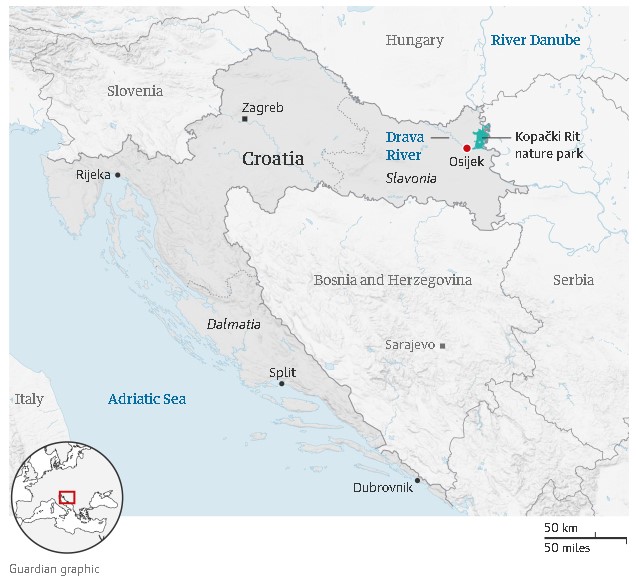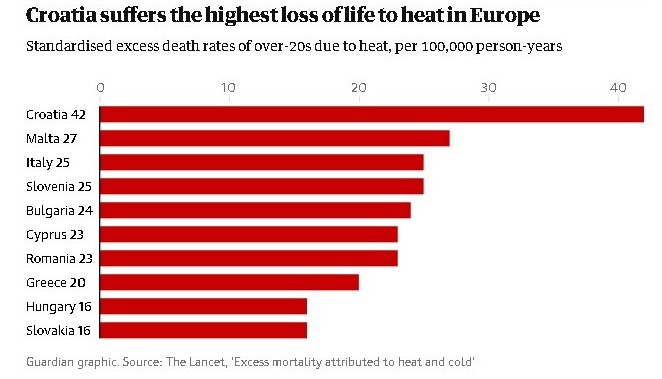GUARDIAN: OSIJEK JE ZBOG VISOKIH TEMPERATURA GRAD S NAJVEĆIM BROJEM SMRTNIH SLUČAJEVA U EU

Hrvatska trpi najveći broj smrtnih slučajeva u EU zbog visokih temperatura.Vruće vrijeme pokazalo se smrtonosnijim u hrvatskom gradu Osijeku nego u bilo kojem drugom europskom gradu. Zašto se malo se čini da se utvrdi zašto je tome tako, donosi portal The Guardian u članku pod nazivom „‘It’s full of green areas: mystery of Europe’s heat death hotspot” kojeg prenosimo u izvornom obliku i to kako slijedi:
By: Ajit Niranjan
Photo: The Guardian
he green LEDs on the cross outside the pharmacy read 38C for the second day running, but the noontime crowds in the centre of Osijek seemed untroubled by the danger that signalled. “We work in the sun but for us it’s no problem,” said Davor, 47, a bike courier with the food delivery service Wolt.
Though many living there may be unaware, this small Croatian city is Europe’s heat death hotspot. In the past two decades, hot weather has proved deadlier in Osijek than in any other city in Europe, a study in the Lancet medical journal found. The researchers modelled temperature and mortality data from the 854 biggest cities in Europe and found Croatians were most likely to died from the heat.
Despite the danger, little has been done to keep people safe – or to work out why they are dying at such a high rate. Doctors and scientists say the health crisis is far greater than people realise, with the public unaware how hard heat hits and politicians unprepared for it to get worse.
“In the last century there were some risks, but not so much,” said Lidija Srnec, a climate scientist at the Croatian Meteorological and Hydrological Service, pointing to a colour-coded chart of temperature alerts on a computer in her office in Zagreb. “But as you approach today, the periods with red alarms are more and last longer.”
As carbon pollution has clogged the atmosphere, trapping sunlight like a greenhouse, Europe has baked in ferocious heat. Hot weather killed 70,000 people across the continent last summer and the death toll in 2023, the hottest year on record, may prove higher still. Doctors say the human cost of a heatwave hinges not just on climatic factors but also how vulnerable people are and how well they respond.
Osijek, a city of 100,000 people near Croatia’s border with Serbia, does not stand out as a city that should suffer from hellish heat. The agricultural Slavonia region in which it sits is hotter than the capital, Zagreb, but not as hot as coastal Dalmatia, which is home to the tourist magnets of Dubrovnik and Split. Local people say the quality of healthcare is typical for the country. The average resident has become older, particularly since Croatia joined the EU in 2013, but the researchers controlled for age.
Adding to the mystery, Osijek is home to nature that should keep it cool. The city sits on the banks of the Drava River, which flows into the Danube 12 miles downstream, and looks out on to Kopački Rit, one of Europe’s biggest wetlands. Urban planners built parks in the city when it was under the rule of the Austro-Hungarian empire.
“Osijek is full of green areas,” said Matijana Jergović, an epidemiologist at the Andrija Stampar Teaching Institute of Public Health in Zagreb. She grew up in a working-class district of Osijek surrounded by concrete, she said, but often escaped to nearby rivers and woods.
The conundrum is not just a problem for Croatia. The hunt for answers in Osijek and in Zagreb, where hot weather has proved only slightly less deadly, could help heat-stricken cities across Europe adapt as the climate grows less hospitable to humans.

On a sweltering August morning this year in Osijek, as pigeons dipped their beaks in a fountain and a shaggy dog sprawled atop the jets of water it periodically spouted, the streets were sparse but the terraces packed. An Indian chef who had worked in much hotter conditions in Dubai said he did not find the Croatian heat so bad. Osijek, he added with a shrug, “feels like my home in Uttarakhand”.
Doctors offer a few theories to explain the death toll. For a start, the bodies of water that surround Osijek are slow-moving or still, which makes the air humid. Lots of water in the air means fewer beads of sweat evaporate off the skin and draw heat from the body. Scientists have warned that “wet-bulb” temperatures that account for heat and humidity are in some parts of the world nearing the limits of what the human body can take.
The Lancet study did not factor humidity into its models but recent research suggests it does not change much, said Pierre Masselot, of the London School of Hygiene & Tropical Medicine, the lead author of the study. “From an epidemiological point of view, humidity doesn’t seem to play a big role in mortality directly, although there’s no denying that there is a response.”
Then there are pre-existing illnesses. Doctors call heat a silent killer because only a fraction of the deaths it triggers are logged as such. While some people die from heatstroke on farms or building sites, with death certificates that name heat as the cause, many more die in hospital beds and retirement homes as they fight off heart and lung disease. Hot days push weak bodies into overdrive and warm nights prevent them from recovering. The result is a spike in excess mortality that shows up only in the statistics.
Scientists say this could play out in two ways in Osijek. A study of Vietnam war survivors in 2020 found exposure to war was associated with heart disease later in life – particularly in women, who for a mix of reasons die at higher rates than men in heatwaves. In Osijek, where some buildings are pockmarked from shells that fell during Croatia’s war of independence with Yugoslavia in 1991, residents may be carrying hidden scars that leave them vulnerable to heat.
“Our parents put us in buses and didn’t know in which town we would end up,” said Jergović, who fled to Austria for three months at the age of 13 and helped other child refugees find host families there.
Food may be another factor. Croatia has the highest share of people who are overweight or obese in Europe. On its coast, people favour a Mediterranean diet of fish, vegetables and wine over meat, potatoes and beer. But Osijek and other Slavonian cities boast a fatty cuisine closer to that of central Europe. The menus in the windows of Osijek’s restaurants offer a hearty fare that clogs arteries and raises blood pressure.
Dinko Pesić, of the local environmental group Zeleni Osijek, said Slavonia’s older residents, in particular, see fatty pork sausages and spicy hot stews as traditions they don’t want to give up. “The diet is not suitable forever-worsening weather.”
Scientists say the explanations are, for now, little more than educated guesses. But they warn that the problem will get worse without urgent action today.
By the banks of the Drava, a persistent whine heralds one sinister aspect of Croatia’s worsening weather. Branimir Hackenberger, a biologist at the University of Osijek who models insect populations, said a person who sits by the river in summer can get bitten 300 times an hour by mosquitoes. “In Osijek, we have more mosquito attacks an hour than in Burkina Faso.”
Croatia has been hit by summer heatwaves followed by flash floods that have helped mosquitoes breed. The insects do not yet carry diseases such as malaria, said Hackenberger, but the ecological conditions for infectious diseases to spread are already there. “All we need is the trigger.”
Beyond cutting its own greenhouse gas pollution, Croatia has little control over the rise in temperatures. What it can do today, experts say, is take simple steps to save lives during heatwaves, such as warning residents and checking in on vulnerable populations.
The Croatian health ministry said it was aware of the Lancet study but had not analysed why Osijek specifically and Croatia in general were so badly hit. It said it already had an early warning system and recommendations for heat protection. It did not say when its heat-health action plan would be published.
People can adapt their behaviour, experts say. Standing outside a football stadium during a match in Zagreb, Željka Štaub, a nurse with a mobile medical company, advised people to drink water and avoid being outside if they could. “Today, we have to pay attention to the people who are drinking beer in the sun,” Štaub said.
In the longer term, cities could stay cool by reducing the traffic heating their streets, and replacing concrete and asphalt with parks and trees. The urban heat island effect raises the temperatures of cities above their surroundings by generating heat and absorbing sunlight.
Hackenberger said Osijek had moved in the wrong direction. Driving down a road lined with stumpy trees and two-storey houses that towered over them, he said that two decades ago the local government had replaced the tall trees in several districts with short ones that provided little shade. Nobody had thought about the heat to come.
“Thirty years ago, we wouldn’t have been able to see these roofs,” he said. “It would have all been green.”




